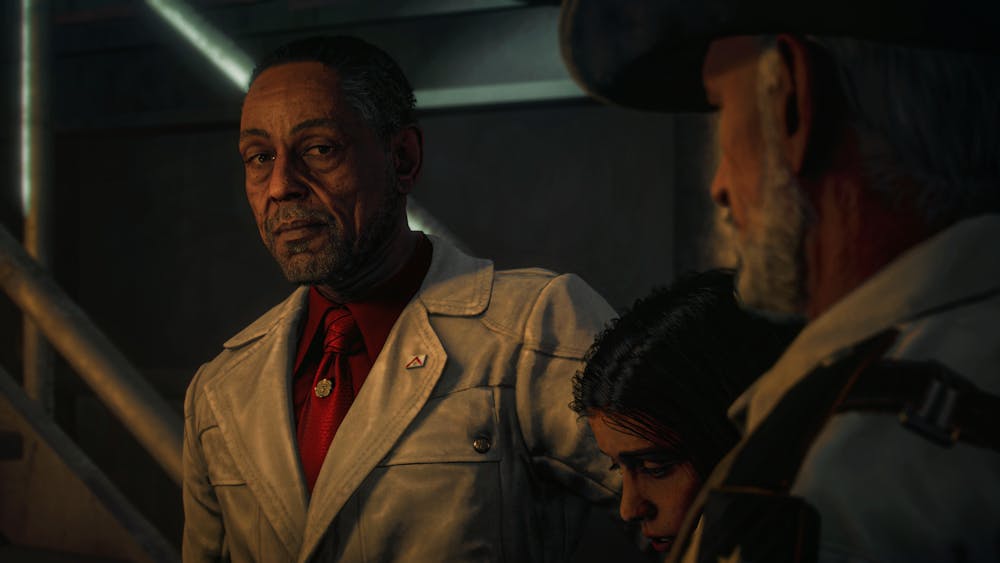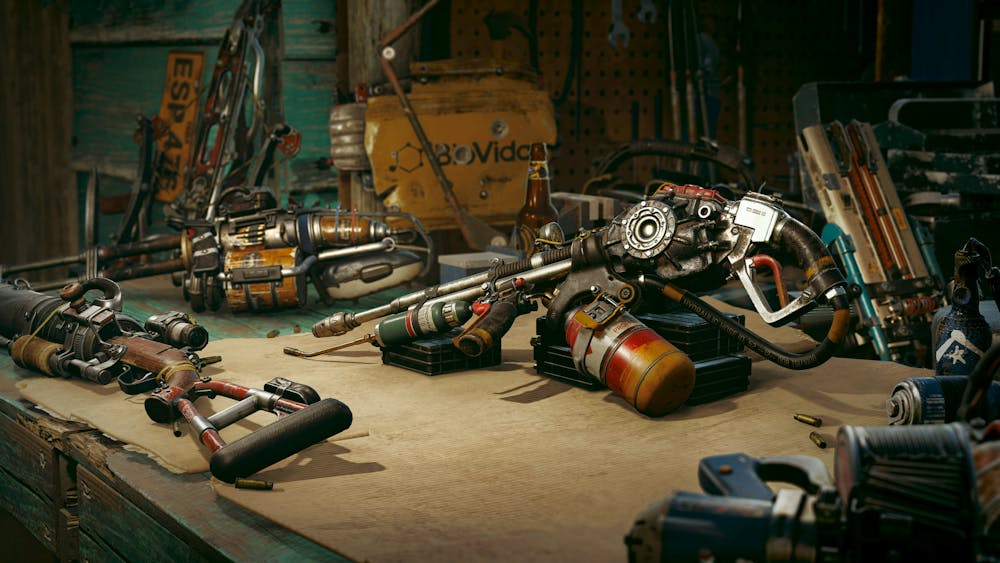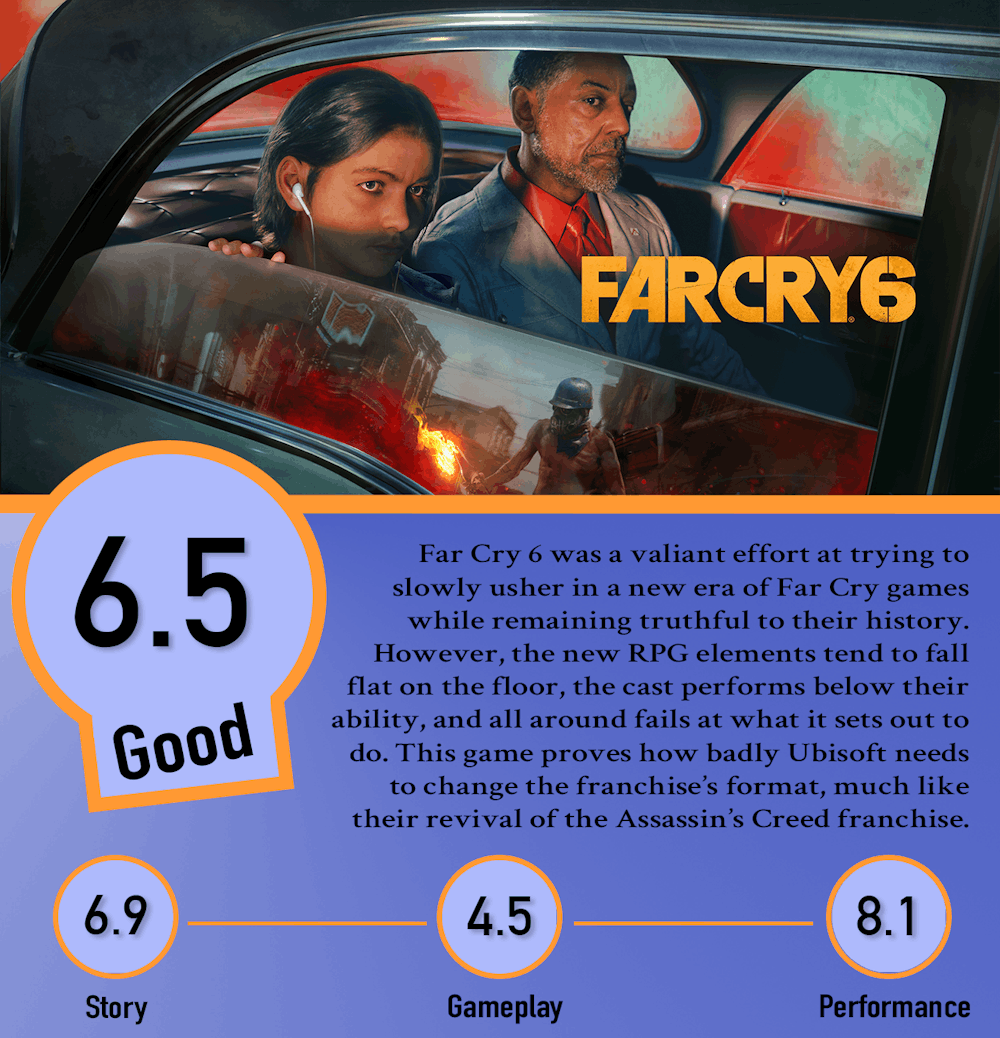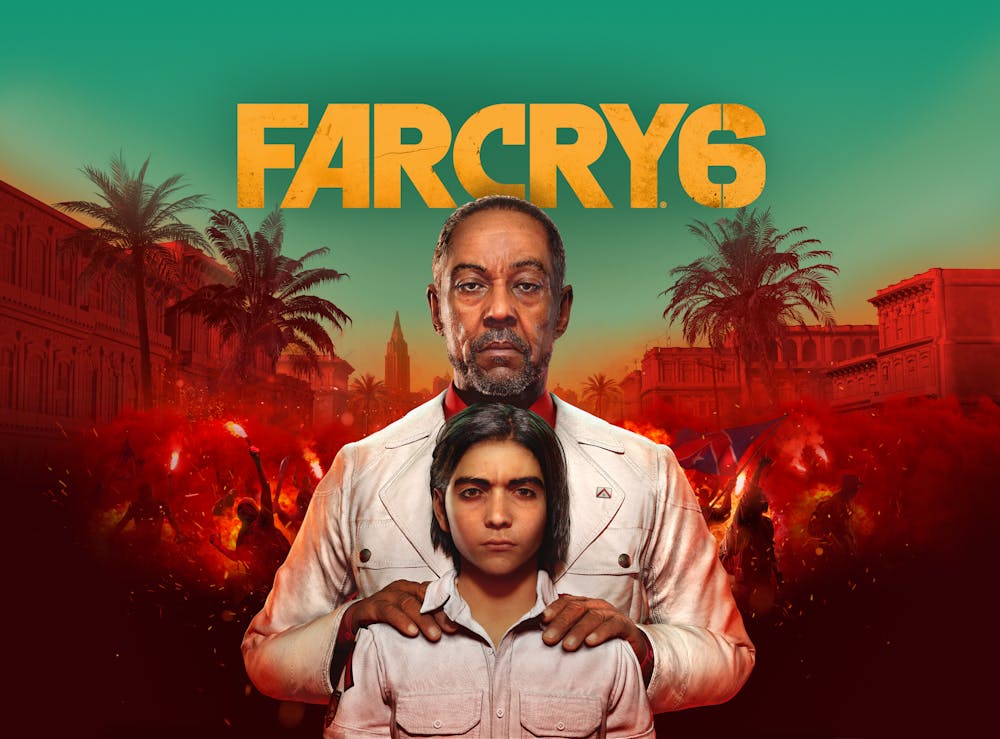Disclaimer: This review is of the Playstation version of the game and was conducted on a Playstation 5. Byte BSU also received a copy of Far Cry 6 to review from Ubisoft.
Much like its more popular brother Assassin’s Creed, the Far Cry franchise is a Ubisoft staple. So it was no surprise when we saw the announcement for Far Cry 6 back in 2020, just two years after the release of the highly praised Far Cry 5. What was shocking was the introduction of popular actor Giancarlo Esposito—famous for his portrayal of Gus in the television show Breaking Bad—as the main villain Antón Castillo, the current president of Cuba-inspired island of Yara who is dealing with a rebellion against him. This was a huge step for fans of the Far Cry franchise as it seemed that not only could Ubisoft give us compelling villains, such as Vaas or Pagan Min, but that we would now possibly be seeing famous actors don the role of villain in such a controversial game franchise.
Unfortunately, where the game wanted to build off of the format of previous titles with its story, gameplay, and performance, it flew too close to the sun and fell flat.
The storyline is simple. It has four basic parts.
Far Cry 6 is about rebellious guerilla fighters in their violent opposition against the current president Antón Castillo. Antón has been sending Yaran people to work in tobacco fields that have been modified and mutated by a poison called Viviro. Far Cry 6, alongside other entries in the franchise, kicks off the game with an explosive intro. Immediately, it thrusts you into a fight between the people of Yara and Antón's soldiers. This is where we are introduced to the main character, Dani, who is on the run from the current president, who hopes to force Dani into dangerous agricultural labor alongside many other Yaran citizens.
Dani escapes with fellow revolutionary Lita heading toward a boat that will transport them to safety. Things go awry as it turns out that one of the passengers is none other than Diego Castillo, Antón’s son, who he is grooming to become president. Wouldn’t you know it, Antón himself makes an appearance as he finds his son and leaves with him, firing machine guns at the ship to take it down. During the shootout, our pair of heroes try to duck for cover as Dani watches Lita get shot before they slam into a metal pipe, rendering them unconscious.

As the players awaken, they are shown a "heartbreaking" scene where Dani talks to Lita as she passes on from her seemingly nonfatal wound. At this point, the players are hardly more than 20 to 30 minutes into the game and are expected to care about Lita, who they’ve spent barely a fraction of that time with. But this soon becomes the driving force for Dani to find the rebels, Libertad, and take down Antón Castillo once and for all.
For the rest of this opening prologue, the players are introduced to a handful of characters who they are supposed to remember, yet have hardly any distinction from one another, and are guided really well on what to do, where to go, who to find, and more. That soon comes crashing down. Once the players meet "The Sword" aka Espada Montero, they are swiftly thrust into the “find out for yourself” attitude. The game no longer identifies what is a story mission and what isn’t. It even proceeds to automatically thrust the player into other missions once they have completed a story mission, rather than pinpointing the next story location. This detail was infuriating and the beginning of my major issues with the game.
Rule number 9: Always deliver expected gameplay
Differentiating story missions from the rest of the experience was frustrating, but even more confusing was the gameplay mechanics. The minutiae of this title didn’t seem to fit the game Ubisoft was attempting to make and what it advertised. Far Cry 6 seems to try and be the biggest and most free-roam Far Cry game yet, but failed to make a valiant impact.

Far Cry 6’s Yara is massive and vastly expansive, it even has a whopping 40+ hour storyline to go with it, but as I progressed through the various locales and story beats, the more I felt odd about the controls and the gameplay. There was no variation. In fact, hardly anything had changed from the style of gameplay from the previous games.
The biggest changes this game has are the inclusion of more role-playing game style armaments or clothing and the removal of the skill tree that was notably in previous games. This was definitely a hard pill to swallow as I was accustomed to the skill trees from prior installments. Now they are gone and replaced with a feeble attempt at introducing more variety into a game that isn’t designed for it. Far Cry, as a franchise, has never been designed for tight role-playing game mechanics—the likes of which you would find in The Witcher or Skyrim. It was always designed as a first-person shooter with the ability to act stealthy, and the skill tree helped build that foundation of gameplay. But Ubisoft made the executive decision to get rid of it and replace it without trying to rework the gameplay in order to allow this new mechanic to help solidify it.
Performances by lions and lambs
Far Cry 6 wasn’t a massive step up in graphical fidelity or dramatic performances. In the game, one of the first things you notice is the graphics and how well the game is running on your hardware. This was no exception for me either. And I will admit, I fell in love with the look of Yara as I glanced upon it for the first time. The game is absolutely stunning. It captures the look and feeling of a beautiful sunset on what I would assume is a nice warm day: The detail in rocks and boulders that you may pass on your journey, the rugged wear of trails that many people have traveled over, and other various small details that the game gorgeously highlights. But it seems as though the landscape and the world around the player is the only area where time was spent making it look nice.

Throughout the game, I noticed an odd sensation whenever I saw a non-playable character walking around or during cutscenes. I soon realized that while the world may be stunning, the character models are lacking. In fact, at times they looked and reminded me of character models from Far Cry 3 or Far Cry 4. It was rather disappointing, especially with how imperative characters are to the game’s narrative.
Besides the shallow attempt at updated character models and their less-than-stellar voice acting, there weren't any major issues I had with the performance. Sure, there were some hiccups and glitches, the most notorious being when Espada froze in place during the "Meet the Monteros" mission, but they were issues I could deal with, especially after having dealt with Cyberpunk 2077’s issues and still loving that game. There weren’t any latency issues, connectivity issues, or frames per second issues. The game ran pretty smoothly.
Graphics weren’t the only issue when it came to the characters, unfortunately. Rather, the lack of updated character graphics only helped to solidify how harsh and stiff a lot of the dialogue in the game felt. At a lot of points, I felt like I was listening to a rehearsal of the actors going through their dialogue rather than the final cut. The only exception to this, barely, was the character El Tigre, a bombastic and energetic elderly man who helped take down Antón’s father in 1967. But one character can’t save a lackluster crew, even when that crew has an actor notorious for his amazing portrayal of a villain in a popular television show.

Images: Ubisoft
Featured Images: Ubisoft




















